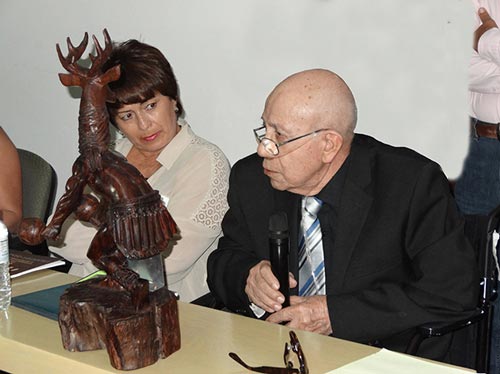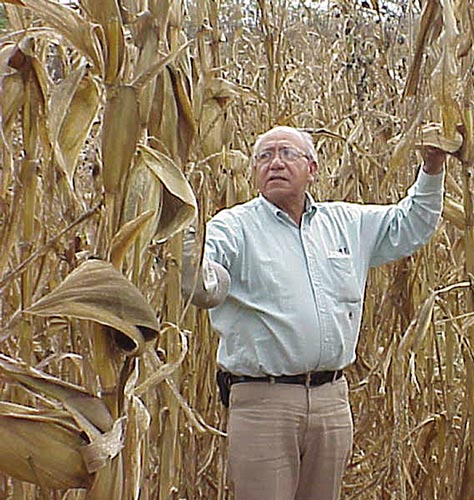
Retired CIMMYT scientist Alejandro Ortega y Corona was honored for his 59 years of maize research at the Meeting for the Coordination of Investigation of Drought Tolerance in Maize from 5 to 6 August. Ortega received recognition for his work with CIMMYT and Mexico’s National Forestry, Agricultural, and Livestock Research Institute (INIFAP) at a special meeting of the Biodiversity Project of Mexico and CIMMYT’s Sustainable Modernization of Traditional Agriculture (MasAgro) initiative in Ciudad Obregón, Sonora State, Mexico.
Kevin Pixley, director of CIMMYT’s Genetic Resources Program, extended thanks and gratitude for the 23 years Ortega served in the organization’s maize program in the areas of entomology, physiology, breeding and pathology. Pixley read letters sent by former CIMMYT maize physiologist Greg Edmeades and Marianne Bänziger, deputy director general for research and partnerships, who worked closely with Ortega in developing drought and heat tolerant maize varieties. A Yaqui dancer statue was presented to Ortega to honor his years of hard work, dedication and leadership at CIMMYT. INIFAP’s Salvador Fernandez and Rafael Ariza congratulated Ortega for his service and dedication.

Erasmo Valenzuela Cornejo, director of INIFAP’s Northwest Regional Research Center of spoke about Ortega’s accomplishments and contributions, among them the mass rearing of insects for CIMMYT maize breeders, QPM maize and screening for heat and drought tolerance. Ortega produced the heat tolerant hybrid H431, which continues to be the number-one hybrid in commercial production for summer plantings in southern Sonora. More than 40 INIFAP scientists, including regional directors and research station superintendents, attended the meeting, as well as five CIMMYT scientists. Scientists working on drought or heat tolerance in maize from other institutions, including the University of Nuevo Leon, Antonio Narro Agrarian Autonomous University and the maize seed company Pioneer–Mexico, also attended the meeting.
Martha Willcox and Gilberto Salinas from MasAgro- Biodiversity organized the meeting to coordinate research evaluating maize accessions from both INIFAP and the CIMMYT germplasm bank, which were collected in arid areas under controlled drought trials to identify new sources of drought resistance. The expansion of infrastructure to conduct large-scale replicated trials on INIFAP stations was a main topic of discussion. Salinas gave an overview of the MasAgro Biodiversity project and Willcox explained the specific objectives for drought and heat phenotyping under the project.
Juan Manuel Hernández and Ariel Ruíz from INIFAP gave a history of the recent INIFAP maize collection, which Ortega coordinated on a national level, and the selection within that collection for semiarid races based on GPS and climatic data. Samuel Trachsel, maize physiologist, explained CIMMYT’s methods of evaluating drought tolerance as well as the infrastructure and equipment needed. Trachsel also spoke about site requirements and precipitation and temperature profiles provided by Kai Sonder to best select sites for development. Juan Burgueno and Willcox spoke on genetic variation within accessions and experimental design.
 Capacity development
Capacity development 
